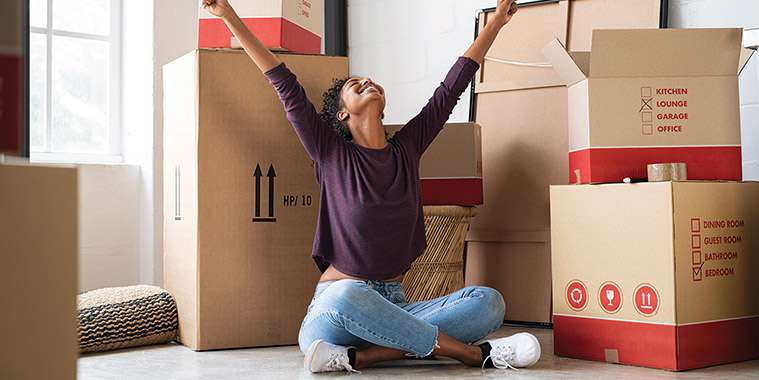You’ve been saving for a down payment, watching your credit like a hawk and are ready to make the big leap into homeownership. What now? And what steps should you take so you don’t feel like you’re wading through a jumble of details?
We’ve put together these 10 steps to guide you on your journey to holding your first set of keys:
1. Prepare to buy
One of the first things you should do is decide where you want to live. Is your heart set on urban living or would a small town be preferable? Enlist the help of a local REALTOR® to research current market prices and get a sense of how much homes cost in your ideal location.
Consider what type of house you picture yourself in; are you leaning toward a house or condo? Both can be amazing places to live. Where condos are typically lower-maintenance but carry maintenance fees, houses, semi-detached homes and free-hold townhouses must be maintained by the owner.
2. Plan your finances
You’ll need to plan for a down payment that’s at least 5% of the total purchase price of the home. Keep in mind that mortgages with less than a 20% down payment will also require default insurance.
Think about the impact of your mortgage payments on your budget. A good way to determine readiness is to use a mortgage affordability calculator to estimate how much you can manage based on your income and current debts. A great calculator to try is at winnipegrealestatenews.com You’ll also want to think beyond your mortgage payments to account for added monthly expenses for maintenance, repairs, upgrades and unexpected surprises.
3. Get pre-qualified
Now that you have a general idea of how much you can afford, it’s time to get pre-qualified for a mortgage by a qualified lender. Any financial institution like a bank or credit union, or a mortgage broker, will manage this process.
Getting pre-approved doesn’t guarantee you will be approved but it can be a good indicator of the price range to aim for. That being said, keep in mind pre-qualification amounts may overestimate affordability, so plan your budget accordingly. You will also need to account for additional costs when arranging a mortgage as well as a list of things to bring when you meet with a lender.
4. Find a REALTOR®
REALTORS® are your home buying MVPs. They are the most familiar with the housing market and will work with you to find the best home based on your budget and needs.
Once you meet your REALTOR®, let them know in detail what you’re looking for in a home, your preferred location and the price range you’d like to stick within so they can help you find and explore different options. From there, they can walk you through the entire home buying process and will be a great resource when it comes to getting to know a new neighbourhood.
5. View properties
You’ve done your due diligence and now comes the exciting part — browsing properties! Search listings in your price range, by location and preferred features and share any that catch your eye with your REALTOR® so they can set up a viewing.
While touring a property, consider:
• Testing the plumbing fixtures.
• Checking the light switches in each room.
• Opening and closing the doors and windows and checking for moisture.
• Looking at other homes on the block to see how well they are maintained.
• Checking the traffic density in the area.
• Confirming parking.
• Is the driveway (if there is one) well maintained?
• Checking proximity to nearby amenities (like schools, shopping, dining, parks or public transportation).
6. Select your mortgage loan
Now is the time to decide on the type of mortgage that’s best for you. It may be helpful to get a good understanding of mortgage terminology and this payment calculator takes the guesswork out of determining different scenarios for interest, amortization period and payment frequency.
Your lender or broker can help you decide what’s best for your unique situation, depending on factors like floating or fixed interest rates, your desired payment frequency and affordability or ensuring that your monthly payments never increase.
7. Make an offer
Now, for the moment of truth: it’s time to make an offer. Your REALTOR® can help you come up with a strategy and prepare a fair offer based on their knowledge and experience, your initial impressions of the home, observations made when viewing it and the asking price. Essentially, what you are willing to pay?
Your REALTOR® can also help you determine any conditions — like financing or inspections — you’d like to include as part of your offer and set a deadline. Generally, 24 to 48 hours is customary to accept or reject the offer.
8. Get a home inspection
Purchase offers generally hinge on a successful home inspection and your REALTOR® can arrange the inspection within a few days of the acceptance of your offer by the seller. It is always recommended that you have the home inspected by a professional before you buy. It will likely cost a few hundred dollars, but this small up-front investment can save you unpleasant surprises and financial woes down the road.
9. Hire a lawyer
Buying a home involves a great deal of legal paperwork. There are likely many qualified real estate lawyers your friends and family can recommend. Your REALTOR® can also share the names of lawyers in your area.
A lawyer handles all the paperwork for transferring the land title and can help you deal with possible pitfalls like zoning issues, unpaid taxes or liens, legislation or — in very rare cases — fraud. A transfer of title generally takes two weeks to complete.
Get a fee estimate from prospective lawyers with an outline of their fee structure and be sure to ask questions if you are unsure of anything. Translating legal verbiage into layman’s terms is an important part of their job.
10. Close the purchase
You’re on the home stretch! All that needs to happen now is to close the deal. Your REALTOR® and lawyer do most of the legwork here, but you should consider the following:
• Start satisfying your end of any conditions of the agreement — your REALTOR® will confirm and document these;
• Purchase homeowners’ insurance to activate on the closing date;
• Contact your lender or broker to finalize the mortgage documents;
• Arrange to have any utilities and services to be connected or switched to your name upon close;
• Meet your lawyer a day or two before closing to sign the closing documents.
Buying a home will likely be one of the biggest single purchases that you’ll make and there’s a lot to know, understand and do. Your REALTOR® is there to help you along every step of your journey to homeownership.
Happy house hunting, and don’t forget to breathe and enjoy the process, you’re about to be a homeowner!
This article was published in a previous issue of the Winnipeg Regional Real Estate News.
— Realtor.ca



